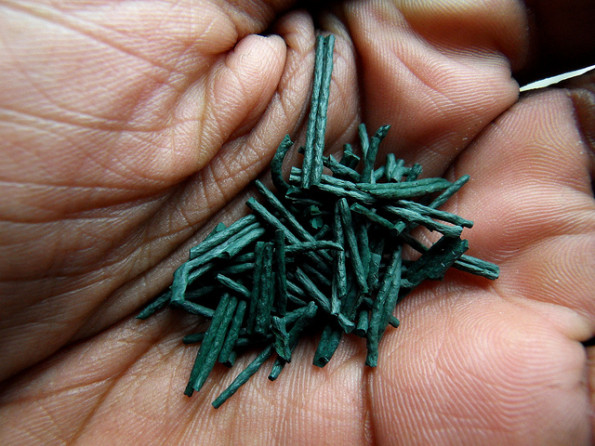Say goodbye to the houseplants you keep forgetting to water, and embrace a new trend: decorative, functional microorganisms.
Innovations in industrial and architectural design might soon bring photosynthesis into your home in a completely new way – by building algae into your décor.
We all share our homes with billions of microorganisms. We tend to think of them as invaders to be sanitized away, if we think of them at all, but two artists have transformed blue-green algae into symbiotic roommates in a practical and beautiful way. Architectural designer Jacob Douenias and industrial designer Ethan Frier have created what they are calling “photosynthetic furniture” by integrating glass tanks of algae into kitchens and living spaces.
If you visit the Living Things Exhibition, on display at Pittsburgh’s Mattress Factory Museum of Contemporary Art, you will walk through a living room, kitchen, and dining room where modern furniture is accented by smooth rounded tanks of algae. The tanks are lit by LEDs from within, creating a pleasantly soft green glow that changes hue as the algae multiplies and grows denser over time. A visitor looking closely at the tanks will see tiny green filaments floating in the growth medium, just large enough to be seen without a microscope. Several of these glowing glass “bioreactors” are arranged thoughtfully throughout each room to provide heat and light for the occupants. As the algae grows, it absorbs carbon dioxide from the room’s air and provides a steady supply of fresh oxygen in return.
Not only décor!
Not quite as simple as fishbowls on a countertop, the algae vessels in the exhibition’s concept rooms are connected by a complex series of tubes and pumps that supply fresh growth medium to the microorganisms. This life support system is run by a control panel in the kitchen that allows adjustment of individual tanks as necessary, in a process as simple as watering and fertilizing houseplants. The setup includes a system of valves and filters for harvesting the algae when they’ve grown thick enough, because Spirulina isn’t just a pretty green oxygen-producer: it’s also food.
Spirulina is an edible algae. Once concentrated and dried, it is often used as a dietary supplement because it’s made up of sixty percent protein by weight and is a source of iron, B vitamins, and healthy fatty acids. Visitors attending special events at the museum will have a chance to sample various dishes and cocktails featuring the Spirulina grown in the Living Things tanks.

Incorporating microorganisms into industrial and architectural design opens up a world of possibilities far beyond protein smoothies and unique conversation pieces. Bioluminescent species of algae could be grown in thin tubes and used as dim nightlights. Various algae and bacterial species could be used to purify drinking water or treat waste. Bacteria that break down plant matter into ethanol or propane could lead to basement bioreactors powering our homes. If microorganisms insist on sharing our homes with us, we may as well put them to work.
The Living Things Exibition will be on display at Pittsburgh’s Mattress Factory Museum of Contemporary Art until March 27th 2016.
Via Livingthings
All images under Creative Commons Licence
